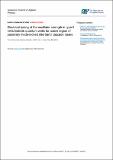Electrical tuning of the oscillator strength in type II InAs/GaInSb quantum wells for active region of passively mode-locked interband cascade lasers
Abstract
Two designs of active region for an interband cascade laser, based on double or triple GaInSb/InAs type II quantum wells (QWs), were compared with respect to passive mode-locked operation in the mid-infrared range around 4 µm. The layer structure and electron and hole wavefunctions under external electric field were engineered to allow controlling the optical transition oscillator strength and the resulting lifetimes. As a result, the investigated structures can mimic absorber-like and gain-like sections of a mode-locked device when properly polarized with opposite bias. A significantly larger oscillator strength tuning range for triple QWs was experimentally verified by Fourier-transform photoreflectance.
Citation
Dyksik , M , Motyka , M , Kurka , M , Ryczko , K , Misiewicz , J , Schade , A , Kamp , M , Höfling , S & Sęk , G 2017 , ' Electrical tuning of the oscillator strength in type II InAs/GaInSb quantum wells for active region of passively mode-locked interband cascade lasers ' , Japanese Journal of Applied Physics , vol. 56 , no. 11 , 110301 . https://doi.org/10.7567/JJAP.56.110301
Publication
Japanese Journal of Applied Physics
Status
Peer reviewed
ISSN
0021-4922Type
Journal article
Description
This project has received funding from the European Commission's Horizon 2020 Research and Innovation Programme iCspec under grant agreement No. 636930 and has also been supported by the National Science Centre of Poland within Grant No. 2014/15/B/ST7/04663.Collections
Items in the St Andrews Research Repository are protected by copyright, with all rights reserved, unless otherwise indicated.

